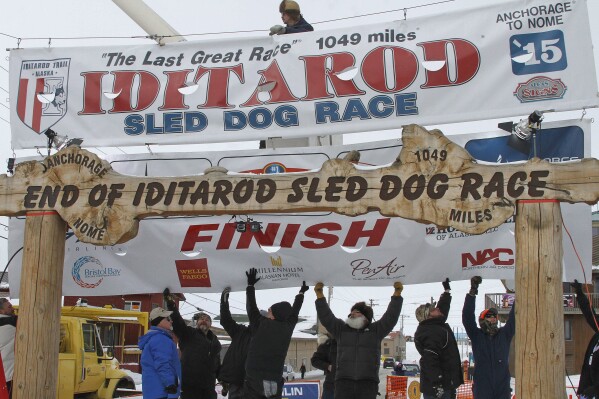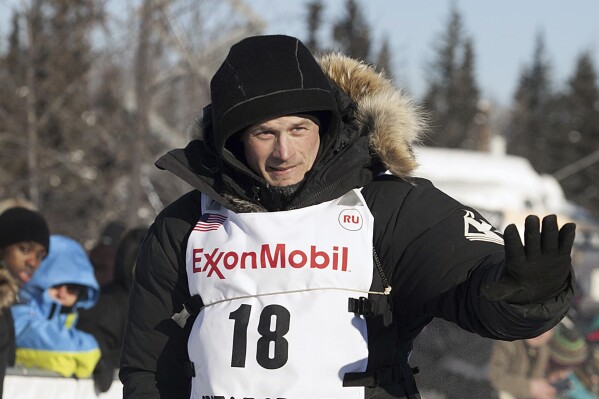Seavey now has the most Iditarod wins, but Alaska’s historic race is marred by 3 sled dog deaths
ANCHORAGE, Alaska (AP) — Alaska’s annual Iditarod dog sled race ended with a victory for the ages: One of the biggest names in the sport came from behind after a moose attack to win the grueling, dayslong contest for an unprecedented sixth time.
But Dallas Seavey’s record-setting win late Tuesday was overshadowed by the deaths of three dogs in this year’s storied endurance race across the Alaska wilderness, and renewed calls from an animal rights group to stop the race. A fourth dog, one of Seavey’s, was severely injured by a moose on the trail.
Seavey, 37, finished the 51st Iditarod in 9 days, 2 hours, 16 minutes and 8 seconds and won just over $55,000 for first place. As he neared the finish line, he jumped off his sled and ran with his dogs, pumping his fists. After he reached the finish line, he hugged each dog on his team — and they gave him sloppy dog kisses as they sat on the winner’s podium.
“This one was supposed to be hard,” Seavey told the crowd. “It had to be special, it had to be more than just a normal Iditarod, and for me, it was.”
The Iditarod Trail Dog Sled Race takes human-and-dog teams across 1,000 miles (1,609 kilometers) of wilderness on a trail that traverses two mountain ranges, the Yukon River and a slice of the frozen Bering Sea before ending in the Gold Rush town of Nome just south of the Arctic Circle.



But the deaths of the dogs on three separate teams, two led by rookie mushers and a third in his second Iditarod, cast a pall over the race as the Iditarod ended a five-year streak without a dog death. Five dogs also died and eight were injured in collisions with snow machines during training before the race on shared-use trails.
People for the Ethical Treatment of Animals, the loudest critic of the Iditarod, called for officials to end the contest once and for all.
“The Iditarod is the shame of Alaska,” PETA Executive Vice President Tracy Reiman said in a statement. “How many more dogs need to die before this stops? Dogs’ lives are worth more than this.”
The Iditarod did not immediately respond to a request for comment.
Mushers Issac Teaford, of Salt Lake City, and Hunter Keefe, of Knik, both voluntarily quit the course after their dogs died, or they would have risked being removed by the race marshal, per Iditarod rules.
The third dog on rookie Calvin Daugherty’s team collapsed on the trail about 10 miles (16 kilometers) before reaching the checkpoint in the village of Shaktoolik. A necropsy is planned, and Daugherty also scratched.
A moose severely injured one of Seavey’s dogs in an attack on the trail early on. Seavey shot and killed the moose with a handgun and gutted it. Race rules require any big game animal killed in defense of life or property to be gutted before the musher moves on. But because he spent only 10 minutes gutting the moose, race officials gave Seavey a two-hour time penalty.
Seavey and his team battled back, and by Tuesday morning they had a three-hour lead over their nearest competitor before sweeping to victory later in the day.
“When you look back at 1,000 miles of what these dogs just covered, the challenges they faced, you can’t swallow that in one bite, but we can have one good step at a time,” he said of his dogs. “And if you can keep doing that, it leads to something.”
Seavey’s name is found throughout the Iditarod record book. In 2005, he became the youngest musher to run in the race, and in 2012, its youngest champion.
Seavey also won Iditarod championships in 2014, 2015, 2016 and 2021. He had previously been tied with now-retired musher Rick Swenson with five titles apiece. Swenson won the Iditarod in 1977, 1979, 1981, 1982 and 1991.
Seavey’s family history is deeply entwined with the Iditarod. His grandfather, Dan Seavey, helped organize and ran the first Iditarod in 1973, and his father, Mitch Seavey, is a three-time champion.
Dallas Seavey almost took a different path in the sports world. He was the first Alaskan to win a USA national wrestling championship when he took the 125-pound Gregco-Roman title in 2003 and trained for a year at the U.S. Olympic Training Center before concussions led him to back to mushing.
The Iditarod started March 2 for 38 mushers with a ceremonial run in Anchorage, followed by the competitive start on March 3 in Willow, about 75 miles north of Anchorage. Seven mushers dropped out of the race this year.
___
This story has been corrected to show that five dogs died in pre-race training, not eight.
Disclaimer: The copyright of this article belongs to the original author. Reposting this article is solely for the purpose of information dissemination and does not constitute any investment advice. If there is any infringement, please contact us immediately. We will make corrections or deletions as necessary. Thank you.






